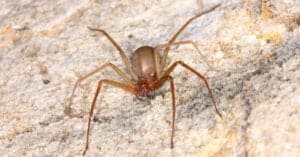When most people think of Texas they think of the Alamo, Tex-Mex and barbecue, and ranching. The Lone Star State also boasts beautiful scenery and a wide variety of animals. You can find everything from ocelots and porcupines to blind salamanders and alligators throughout the state. Texas is also home to various species of spiders including jumping spiders and tarantulas.
Here is a quick look at the 10 spiders making their homes in the Lone Star State that we have selected to discuss:
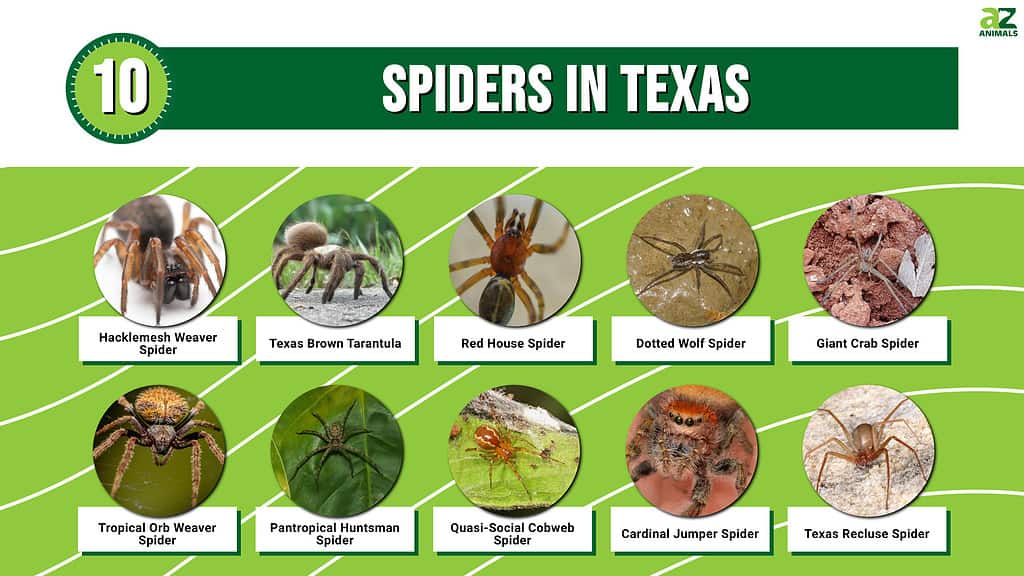
Now, read on to discover some fascinating facts about these spiders (and one tarantula)!
#10. Texas Recluse
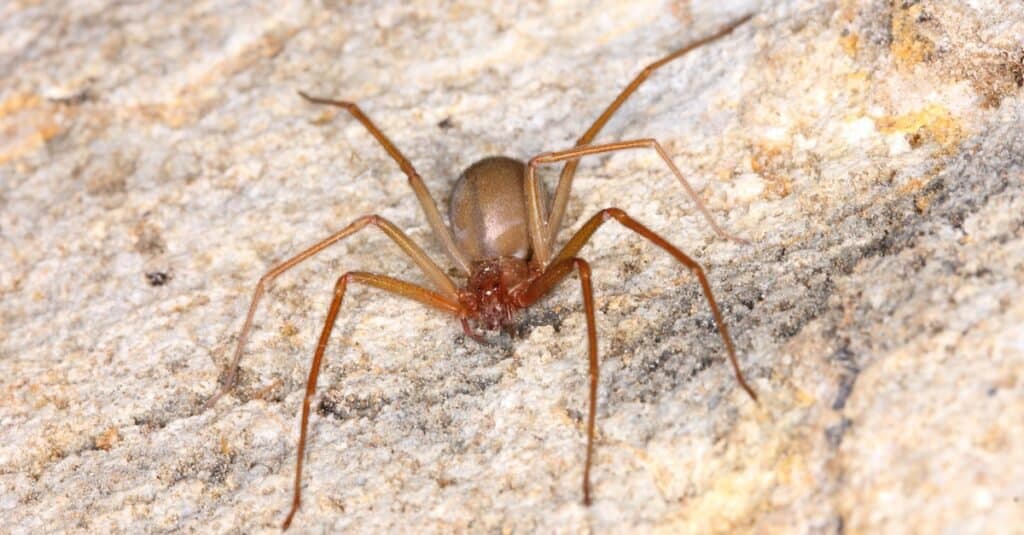
A recluse spide.
©Pong Wira/Shutterstock.com
The Texas recluse, Loxosceles devia, belongs to the recluse spider family Sicariidae. It is one of the most common recluse spiders in Texas and also ranges throughout Mexico.
Female and male Texas recluses measure around the same size. They average around 7.5 millimeters long with a leg span of up to 38 millimeters. Most Texas recluses appear primarily yellowish-brown or tan. Unlike most other spiders, they only have 6 instead of 8 eyes. Additionally, the Texas recluse lacks the violin-shaped marking typically present on most recluses.
Texas recluses spin irregularly-shaped cobwebs that they use to catch prey. You can typically find them under stones or abandoned rodent burrows. They possess necrotic venom that can damage human skin as well as the surrounding tissue. These skin lesions can take a while to heal and may require medical attention.
#9: Cardinal Jumper
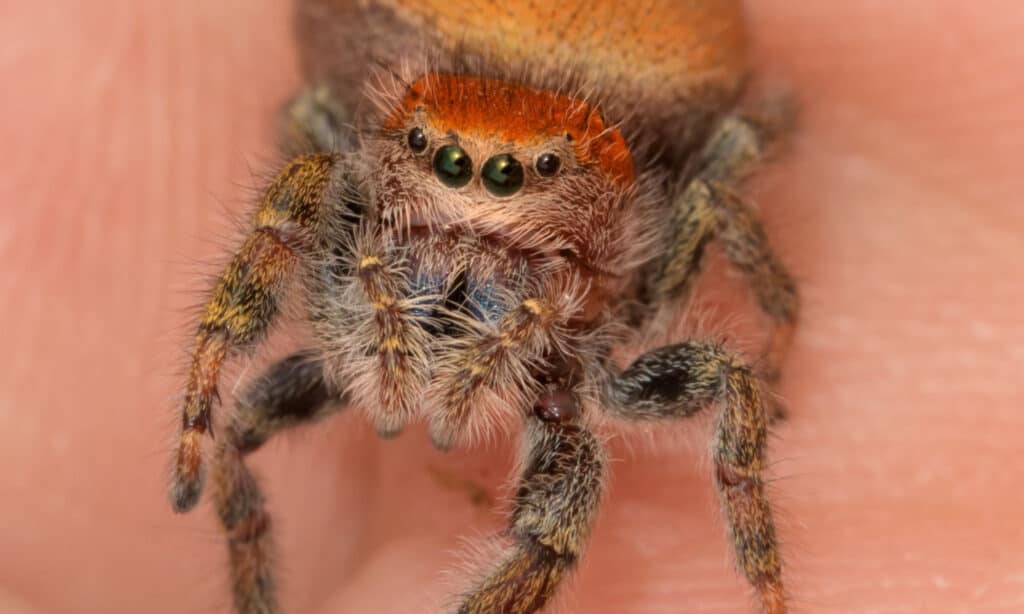
The cardinal jumper mimics the mutillid wasps in the genuse
Dasymutilla.
©Sari ONeal/Shutterstock.com
Phidippus cardinalis, or the cardinal jumper, is a member of the jumping spider family Salticidae. You can find these tiny jumping spiders in Texas as well as throughout the eastern United States and Mexico.
On average, cardinal jumpers measure around 6 millimeters long, with females typically measuring larger than males. The abdomen and carapace on the male look bright orangish-red while the legs appear black. Meanwhile, females have a dusty orange or red carapace and abdomen and brownish-grey legs. They mimic the mutillid wasps in the genus Dasymutilla known as velvet ants.
Cardinal jumping spiders do not use webs to capture prey. Instead, they actively wander in search of food which they kill by jumping on and biting with their large mouthparts or chelicerae. Due to their small size, their bite is not medically significant.
#8: Quasi-Social Cobweb Spider
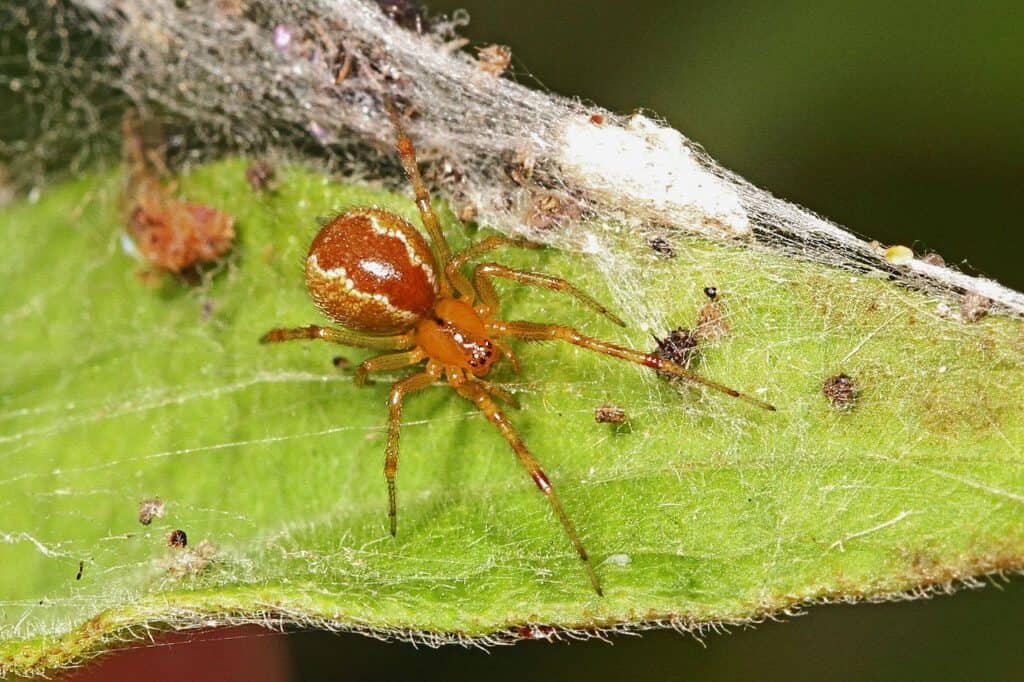
The quasi-social cobweb spider often lives in large, social communities
©Judy Gallagher / CC BY 2.0, via Wikimedia Commons – License
The quasi-social cobweb spider, Anelosimus studiosus, belongs to the cobweb spider family Theridiidae. It ranges throughout both North and South America in tropical and temperate regions.
Adult quasi-social cobweb spiders measure about 7 millimeters long, with females generally measuring larger than males. The carapace looks reddish-brown while the abdomen looks light brown. That said, they often sport a dark brown stripe down the center of the abdomen bordered by 2 wavy white bands. Meanwhile, their legs appear amber with dark bands.
Unlike most spiders in Texas, quasi-social cobweb spiders come in two common behavioral types; social spiders that live in communities and asocial, solitary spiders. The social type will live in proximity to one another and also share food and raise spiderlings together. On the other hand, asocial spiders live on their own. Their bite is not medically significant.
#7. Pantropical Huntsman Spider
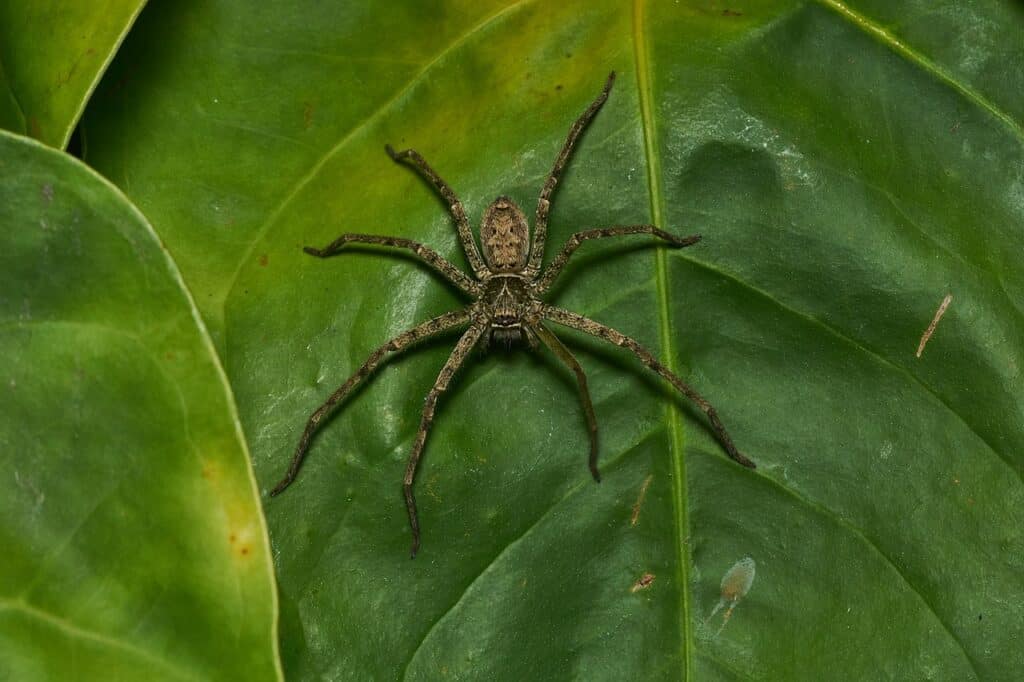
The pantropical huntsman spider is also known as the cane spider and giant
crab spider
.
©© 2017 Jee & Rani Nature Photography / CC BY-SA 4.0 via Wikimedia Commons – License
Heteropoda venatoria, or the pantropical huntsman spider, belongs to the family Sparassidae. In some regions, it also goes by the name the cane spider and giant crab spider. It is one of the largest spiders in Texas and can be found in tropical climates throughout the world.
Adult pantropical huntsman spiders range from 20 to 25 millimeters long, with males typically measuring smaller than females. That said, males usually have longer legs than females. They look predominantly tan or light brown and feature dull black markings. Meanwhile, they sport a creamish-tan band down the middle of the carapace and a cream or yellow band in the space in front of the eyes.
Pantropical huntsman spiders do not use webs to trap prey and instead actively hunt their food. In addition to insects, larger specimens will even attack and eat scorpions and bats. While not dangerous, their bite can be painful.
#6. Tropical Orb Weaver
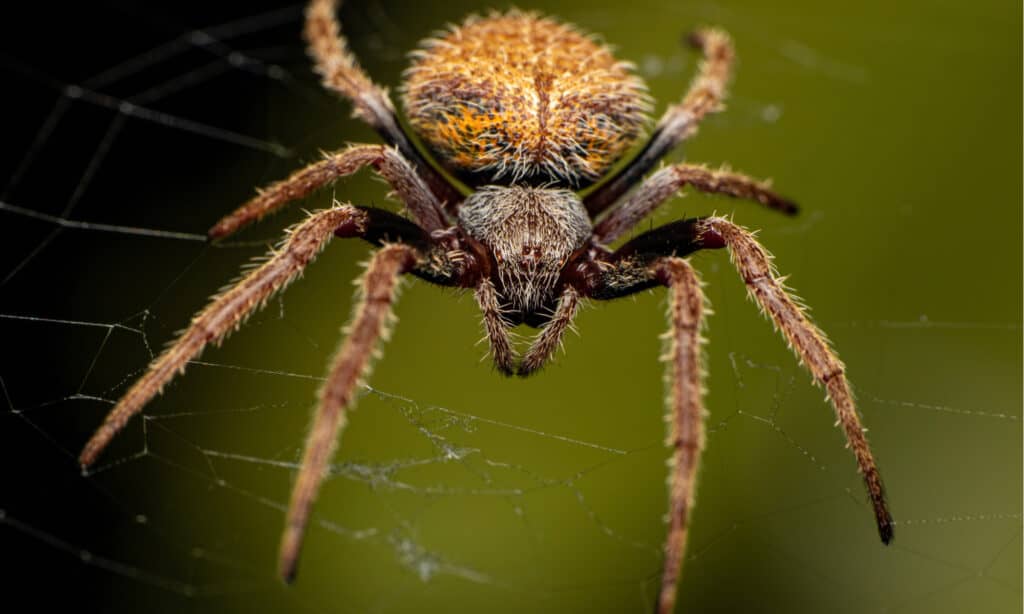
The tropical orb weaver comes in various colors and features various markings.
©Tommy Daynjer/Shutterstock.com
Eriophora ravilla is more commonly known as the tropical orb weaver. It belongs to the orb weaver family Araneidae and ranges throughout much of the Americas from the United States to Brazil.
Adult females can reach up to 25 millimeters long. Meanwhile, males usually only measure about half that size. Tropical orb weavers rank as one of the most difficult spiders in Texas to identify because they vary widely in appearance. On average, they look dull brown with no specific markings or patterns. Some feature greenish-yellow diamond-shaping markings on the abdomen, while others look primarily orange or green with black abdominal markings.
Tropical orb-weavers hunt at night and make large webs that they use to trap their prey. Their bite is not medically significant but may cause some pain or swelling.
#5. Giant Crab Spider
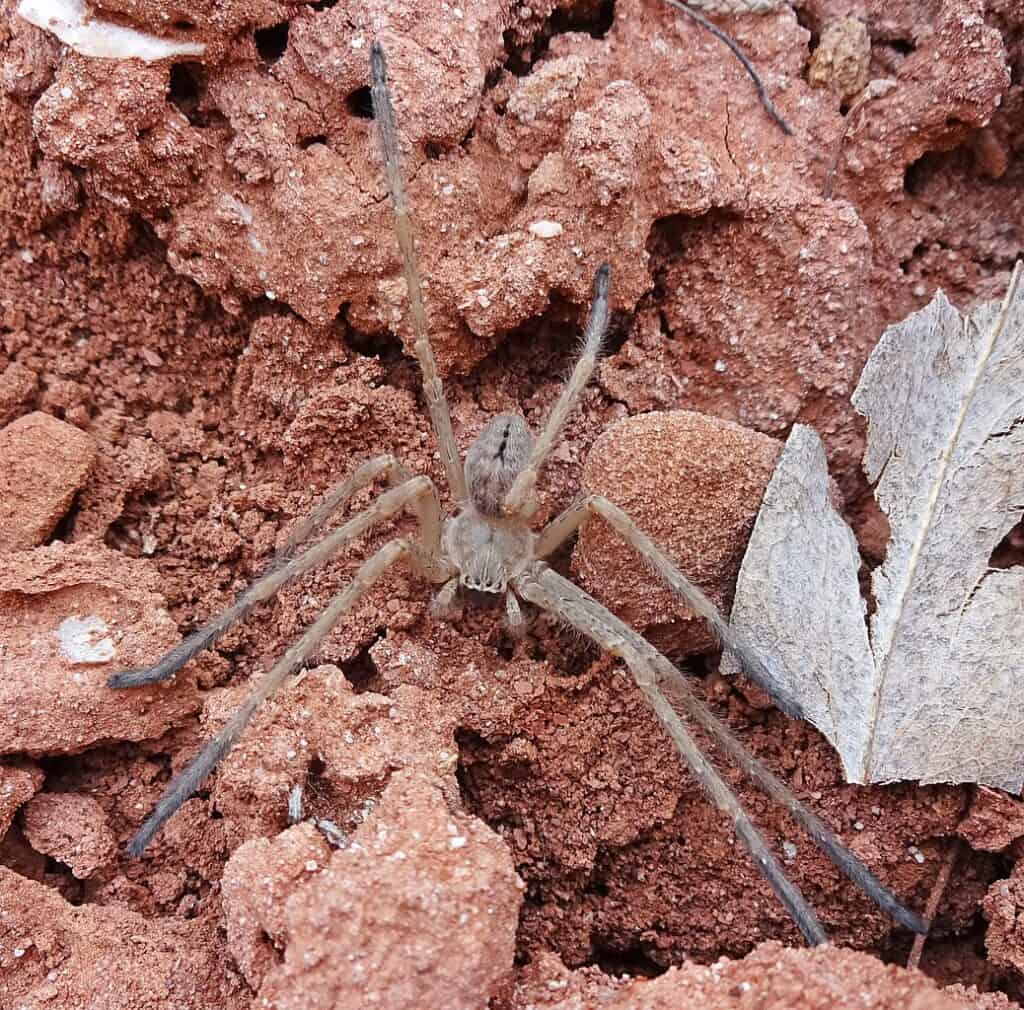
The giant crab spider is known to be quite aggressive.
©Andrey Zharkikh from Salt Lake City, USA / CC BY 2.0, via Wikimedia Commons – License
The giant crab spider, Olios giganteus, is the second member of the Sparassidae family to make our list of spiders in Texas. You can find it throughout the western United States and parts of Mexico.
At their largest, adult giant crab spiders measure 6 inches long with their legs extended. Meanwhile, they average around 20 millimeters long in terms of body length. Most specimens appear primarily light brown, tan, orange, or black. In addition to their large size, you can identify them by the Y-shaped markings on the top of the abdomen.
Giant crab spiders actively hunt for insects and other spiders instead of using webs to catch prey. They can run incredibly fast and usually overwhelm their prey with their power. Due to their aggressive nature — particularly when protecting their eggs — most people tend to avoid them. Along with pain, their bite can cause swelling, headaches, or nausea.
#4. Dotted Wolf Spider

The dotted wolf spider possesses highly reflective eyes.
©HWall/Shutterstock.com
Rabidosa punctulata, or the dotted wolf spider, belongs to the wolf spider family Lycosidae. You can often find these large spiders in Texas and throughout the eastern and southern United States.
Adult specimens measure around 17 millimeters long, with males typically measuring smaller than females. They look primarily light brown except for two dark brown stripes down the cephalothorax and one stripe down the middle of the abdomen. Additionally, they sport numerous back spots on the bottom of the abdomen, hence their name.
Dotted wolf spiders spend most of their time in weeds or tall grass looking for food. They do not use webs to catch prey and instead actively hunt insects and other spiders using their speed, strength, and stealth. Despite their large size, their bite is not medically significant but can be painful.
#3. Red House Spider
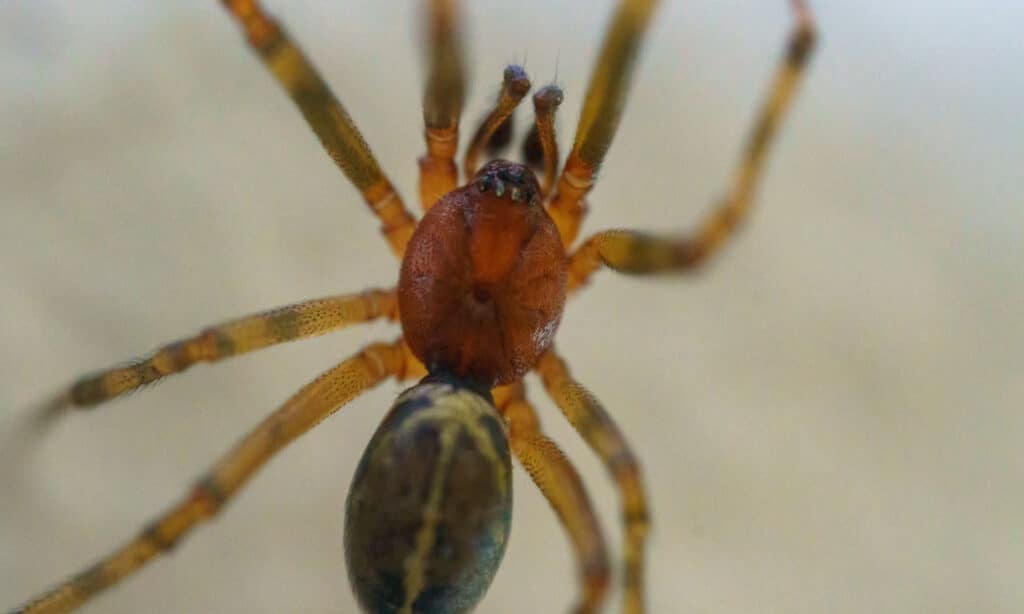
The red house spider sometimes get confused for black widows due to females’ hourglass-shaped markings.
©M-Production/Shutterstock.com
The red house spider, Nesticodes rufipes, belongs to the family Theridiidae and is the only member of the genus Nesticodes. It is one of the more common household spiders in Texas. You can also find it throughout the southwestern and southeastern United States and Australia.
Adult red house spiders measure 5 to 8.3 millimeters long, with females typically measuring larger than males. They appear almost uniformly red in color, hence their name. That said, some specimens can look more orange or brown. Additionally, females sport a red marking similar to the hourglass-shaped marking on a black widow’s abdomen.
You can often find red house spiders in or near human dwellings. They make tangled cobwebs that they use to capture prey and often fiercely protect their webs. Due to their small size, their bite is not medically significant. However, their bite can cause some pain, redness, and swelling.
#2. Texas Brown Tarantula

Texas brown tarantulas wait near the entrance of their burrows and ambush prey that wander too close.
©texas brown tarantula/Shutterstock.com
Aphonopelma hentzi is one of the most well-known spiders in Texas. Best known as the Texas brown tarantula, it also goes by the name the Oklahoma brown tarantula or Missouri tarantula. It belongs to the tarantula family Theraphosidae and ranges throughout the southern United States and Mexico.
Adult Texas brown tarantulas measure up to 4 inches long with their legs extended, with males normally measuring smaller than females. They look predominantly brown, hence their name. That said, they range in color from light to dark brown, and their colors usually look more vibrant after they molt.
Texas brown tarantulas build burrows that they use for protection and to catch their prey. They wait near the entrance of the burrow and ambush insects and invertebrates that wander too close. People often keep them as pets due to their docile nature and females can easily live 40 years in captivity.
#1. Hacklemesh Weaver

The hacklemesh weaver builds a disorganized web that it uses to catch its prey.
©Eric Isselee/Shutterstock.com
The hacklemesh weaver, Metaltella simoni, belongs to the family Amaurobiidae. It is not to be mistaken with the more dangerous spider of the same name found in Australia. You can find these spiders in Texas and throughout parts of the southern United States.
Adult hacklemesh weavers tend to measure from 6 to 11 millimeters long, with females measuring larger than males. The abdomen looks primarily tan or dark brown while the carapace and legs look reddish-brown. People often confuse them with brown recluses, but they lack the latter’s distinctive violin-shaped marking.
Hacklemesh weavers build mesh-shaped webs, which is where they get their name. Unlike most other orb weavers, their webs appear rather disorganized and asymmetrical. Their bite is venomous but not medically significant.
Summary of 10 Spiders in Texas:
| Common Name | Scientific Name | Size in Inches | Type of Web | Bite Effect |
|---|---|---|---|---|
| Hacklemesh Weaver | Metaltella simoni | 0.24-0.43 | Disorganized, mesh-shaped | Venomous, but not dangerous |
| Texas Brown Tarantula | Aphonopelma hentzi | 4 | None, build burrows | Large fangs, so treat the wound. |
| Red House | Nesticodes rufipes | 0.2-0.33 | Tangled cobwebs | Possible redness, swelling, and pain |
| Dotted Wolf | Rabidosa punctulata | 0.67 | None; hunt prey | Possible pain from large bite |
| Giant Crab | Olios giganteus | Body 0.79; legspan 6 | None; hunt prey | Pain, swelling, headaches, nausea |
| Tropical Orb Weaver | Eriophora ravilla | 0.98 | Large | Possible pain or swelling |
| Pantropical Huntsman | Heteropoda venatoria | 0.79-0.98 | None; hunt prey | Possibly painful |
| Quasi-Social Cobweb | Anelosimus studiosus | 0.28 | Cobweb | Not significant |
| Cardinal Jumper | Phidippus cardinalis | 0.24 | None; hunt prey | Not significant |
| Texas Recluse | Loxosceles devia | Body 0.3; legspan 1.5 | Irregularly-shaped cobwebs | Necrotic venom; medical attention recommended |
The photo featured at the top of this post is © Wright Out There/Shutterstock.com
Thank you for reading! Have some feedback for us? Contact the AZ Animals editorial team.





